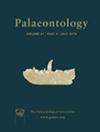Dental microwear texture analysis reveals a likely dietary shift within Late Cretaceous ornithopod dinosaurs
IF 2.3
2区 地球科学
Q1 PALEONTOLOGY
引用次数: 0
Abstract
Dinosaurs were the dominant megaherbivores during the Cretaceous when angiosperms, the flowering plants, emerged and diversified. How herbivorous dinosaurs responded to the increasing diversity of angiosperms is largely unknown due to the lack of methods that can reconstruct diet directly from body fossils. We applied dental microwear texture analysis (DMTA), an approach that quantifies microtopography of diet-induced wear marks on tooth surfaces, to ornithopods, the dinosaur clade that includes taxa with the most sophisticated masticatory system. We found that Late Cretaceous ornithopods have significantly rougher dental microwear texture (DMT) compared to pre-Late Cretaceous ornithopods, and DMT variation increased in hadrosaurids, a derived Late Cretaceous ornithopod clade. These changes indicate a likely temporal dietary shift towards more abrasive foodstuffs within ornithopods, probably due to the increased ingestion of phytoliths (amorphous silica bodies in plants). Phytoliths are a main source of rough DMT in modern herbivores, along with exogenous dust and grit, and were generally more concentrated in Late Cretaceous angiosperms than in other major plant groups. Our results show that DMTA of the occlusal enamel surface can be used to reconstruct the diets of herbivorous dinosaurs, with a resolution superior to conventional methods.牙齿微磨损结构分析揭示了晚白垩纪鸟脚亚目恐龙可能的饮食转变
在白垩纪,恐龙是主要的大型食草动物,当时被子植物,开花植物,出现并多样化。由于缺乏直接从身体化石中重建饮食的方法,食草恐龙是如何应对被子植物日益增加的多样性的,这在很大程度上是未知的。我们将牙齿微磨损纹理分析(DMTA)应用于鸟脚亚目,这是一种量化牙齿表面饮食引起的磨损痕迹的微地形的方法,包括具有最复杂咀嚼系统的分类群。我们发现,与前晚白垩世鸟脚亚目相比,晚白垩世鸟脚亚目的牙齿微磨损纹理(DMT)明显更粗糙,并且在鸭嘴龙(hadrosaurids)中,DMT的变化有所增加。这些变化表明,鸟脚亚目动物的饮食可能在时间上向更具磨蚀性的食物转变,这可能是由于植物岩(植物中的无定形硅体)的摄入增加。植物岩是现代食草动物粗DMT的主要来源,与外源粉尘和沙砾一起,植物岩在晚白垩世被子植物中比在其他主要植物类群中更为集中。结果表明,牙合牙釉质表面DMTA可以用来重建食草恐龙的饮食,分辨率优于传统方法。
本文章由计算机程序翻译,如有差异,请以英文原文为准。
求助全文
约1分钟内获得全文
求助全文
来源期刊

Palaeontology
地学-古生物学
CiteScore
5.60
自引率
3.80%
发文量
43
审稿时长
6 months
期刊介绍:
Palaeontology publishes a wide variety of papers on palaeontological topics covering:
palaeozoology
palaeobotany
systematic studies
palaeoecology
micropalaeontology
palaeobiogeography
functional morphology
stratigraphy
taxonomy
taphonomy
palaeoenvironmental reconstruction
palaeoclimate analysis and biomineralization studies.
 求助内容:
求助内容: 应助结果提醒方式:
应助结果提醒方式:


